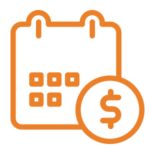About Student Loans
Seven out of 10 college students take out student loans during their college years. Are you one of them?
The US Department of Education, state governments, and private lending institutions all offer student loans. Here’s a rundown along with links to pages that provide more information about each type of loan.
Under the Federal Direct Loan Program (FDLP, also known as Direct), the US Department of Education makes a loan through the student’s school to help a student or parent pay the costs of the student’s education beyond high school.
The FDLP offers several types of student loans: Direct Subsidized, Direct Unsubsidized, Direct PLUS (for parents of dependent undergraduate students, and graduate and professional students), and Direct Consolidation.
These student loans have several advantages over private loans issued by a bank or other financial institution:
- Interest rates are low
- Application and approval processes are uncomplicated
- Loans are available to both students and parents
- Direct Subsidized and Direct Unsubsidized loans aren’t contingent upon a credit check
- A student is not required to make payments on a Direct Subsidized, Direct Unsubsidized, or Direct Student PLUS loan while enrolled in school on at least a half-time basis; in addition:
- For Direct Subsidized or Direct Unsubsidized loans, borrowers aren’t required to make payments for the six-month period after they drop below half-time enrollment
- For Direct PLUS loans first disbursed on or after July 1, 2008, student borrowers can defer payments for the six-month period after they drop below half-time enrollment
- The federal government pays the interest on certain loans while the student is in school on at least a half-time basis, in a grace period, or in a period of deferment
- Parents can defer payments on Direct Parent PLUS loans while they’re enrolled in school on at least a half-time basis. In addition, for a Direct Parent PLUS loan first disbursed on or after July 1, 2008, a parent, upon his or her request, can defer payments:
- For the six-month period after the parent drops below half-time enrollment
- While the student for whom the parent borrowed is enrolled at least half time, and for the six-month period after the student drops below half-time enrollment
Each school that participates in the Federal Perkins Loan Program has a very limited amount of funds with which to make Perkins Loans, so it’s important for a student to submit his or her Free Application for Federal Student Aid (FAFSA) early to be considered for one. A student awarded a Perkins Loan must sign a Master Promissory Note (MPN).
The chart below shows the maximum Perkins Loan funds a student can receive. The amount a student is awarded may be less than the maximum, and will depend on the student’s financial need, the student’s other estimated financial assistance, and the availability of funds at the school.
| Undergraduate students | Up to $5,500 a year (aggregate maximum of $27,500 as an undergraduate) |
| Graduate students | Up to $8,000 a year (aggregate maximum of $60,000, including undergraduate loans) |
| Undergraduate students | Up to $5,500 a year (aggregate maximum of $27,500 as an undergraduate) |
| Graduate students | Up to $8,000 a year (aggregate maximum of $60,000, including undergraduate loans) |
How the Funds are Delivered
A student’s school is the Perkins Loan lender and disburses the loan funds directly to the student or credits the student’s school account. Generally, the school disburses the loan in at least two payments during the academic year.
Paying Back the Loan
A student begins repayment on a Perkins Loan after ceasing to be enrolled at least half time and after a nine-month grace period. Borrowers have as long as 10 years to repay the loan. Perkins Loans do not have repayment plan options. Borrowers must repay the school that loaned the money, or its loan servicing agent. The minimum payment is $40 per month.
Perkins Loans have deferments and forbearances, and loan cancellation options are available under certain circumstances. The MPN provides information on these options. A student must apply for them through the school or its loan servicing agent, and approval is not automatic.
Perkins Loans may be included in a Direct Consolidation loan; however, a student who takes advantage of this option will lose cancellation benefits that are available only under the Federal Perkins Loan Program.
The Texas College Access Loan Program
When a student applies for financial aid using the Free Application for Federal Student Aid (FAFSA), the US Department of Education estimates how much the student and his or her family can afford to spend for the upcoming year of education. The student’s school then subtracts this expected family contribution (EFC) from the school’s cost of attendance (COA). This difference is the student’s financial need.
The school may try to meet that need by awarding grants, scholarships, college work study, and/or federal student loans. For many students, however, the amount of aid awarded by the school isn’t enough to enable them to pay all the costs of their education.
The Texas College Access Loan (CAL) Program is designed to help with this situation. Families may use CAL to make up part or all of the gap between their cost and other available aid. Families don’t have to demonstrate financial need to take advantage of CAL, but the student borrower or a loan co-signer does need to demonstrate a good credit record to be eligible for a loan.
Students who qualify for CAL can enjoy benefits they might not receive from privately issued loans, such as a fixed interest rate of 6.6 percent, a six-month grace period after the borrower leaves school, no interest capitalization, and several repayment plan options.
Visit the program’s website for information on student eligibility, loan fees and interest rates, repayment information, and a link to a loan application page.
When federal, state, and institutional financial aid programs don’t cover your college costs, you might consider private loans. To help you make an informed decision about taking out a private student loan, you must complete and file a Private Education Loan Applicant Self-Certification Form with your lender before you receive a private student loan. This form will tell you that:
- Free or lower-cost federal, state, or school aid may be available in place of, or in addition to, a more costly private loan.
- Receipt of a private education loan may reduce your eligibility for free or low-cost federal, state, or school aid.
- To apply for federal grants, loans, and work-study, you must submit a Free Application for Federal Student Aid (FAFSA).
Here are a few frequently asked questions about private student loans. If you have more questions about student loans, private or otherwise, talk to your school’s financial aid office.
How does a private loan differ from a federal loan?
Private loans differ from federal loans in a variety of ways. First, the US Department of Education makes federal student loans; you’ll have to find a lender who makes private loans. Your school may be able to provide you with the names of lenders who make private loans to their students.
A private lender will check your credit before it determines whether to approve your loan. If you have adverse credit, or lack sufficient credit history, your application may be denied or you may be asked to provide a co-signer (also known as an endorser) with a good credit history. By contrast, many federal loans do not have a credit requirement.
Other important differences include loan fees and interest rates, which generally are higher for private loans. Also, repayment terms usually aren’t as flexible as they are for federal loans. Deferment options are more limited, and few if any lenders offer options to discharge (forgive) a private loan under certain circumstances.
Here are some key differences between private and federal loans, and questions you should ask yourself and prospective lenders.
| Factors to consider | Private loans | Federal loans | Questions to ask |
|---|---|---|---|
| Interest rates | Variable interest rates are tied to key interest rates, such as LIBOR or the prime rate, plus a margin. The interest rate offered by the lender may also depend on your credit rating or the rating of your co-signer, as well as other non-financial factors. | Federally set, fixed interest rate by loan type | Which loan offers the best interest rate? How often does the interest rate vary? What rate will I qualify for based on my credit rating? |
| Loan fees and late charges | Lenders may set loan fees and late charges based on your credit rating or the rating of your co-signer. | Federally set loan fees by loan type, federally set late charges | What happens to my loan balance, interest rate, and credit rating if I’m late on a loan payment? |
| Repayment options | Loan discharge, loan forgiveness, and forbearance are generally not available, and deferment options are limited. | Certain eligible borrowers may elect to defer repayment or request forbearance. Loan discharge and forgiveness are available under certain circumstances. | If I return to school, experience economic hardship, become totally and permanently disabled, or die, what are my responsibilities toward the lender? Can my obligation be deferred or discharged? |
| Co-signers/endorsers | Lenders generally require a credit check, and may have lending criteria such as a minimum loan amount, a creditworthy co-signer, or an income requirement. | A co-signer is not required for a Federal Direct Loan. However, one may be required for a Federal PLUS Loan, either for a parent borrower on behalf of a dependent undergraduate student, or for a graduate or professional student borrower. | Do I have a good credit rating? What other lending criteria does the lender have? If I need a co-signer, do I have someone creditworthy who would be willing to co-sign with me? |
How do I compare private loans?
For each loan that you research, consider:
- Interest rates: What is the interest rate on the loan? How often does it vary and how is it calculated? How would obtaining a creditworthy endorser or co-signer affect the interest rate? When does interest begin accruing? If you cannot afford to make payments while attending school, will the lender postpone payments and allow the interest to be capitalized (added to the principal)? If so, how often will capitalization occur?
- Loan fees: What are the loan fees? How are they collected — are they charged on top of the requested loan amount or subtracted from the total loan amount to be disbursed? Will you be charged a fee when you enter repayment? Are there fees associated with prepaying the loan?
- Repayment terms and period: When will you begin repayment on the loan? Can repayment be postponed until after you graduate or leave school? What are your repayment options and what are their advantages and disadvantages? How long will you have to repay the loan? If you use the maximum or minimum repayment period, what amount of interest will you pay over the life of the loan? What’s the charge for a late payment?
- Repayment incentives: Are there any rewards for a certain number of on-time payments in terms of principal reductions, interest rate reductions, or forgiveness of remaining balances below a certain amount?
How do I apply for a private loan?
Before borrowing a private loan, carefully consider your debt and repayment obligations on all loans. Determine how much you need to borrow by working out a budget for your educational costs and subtracting all of your available resources for those costs.
Borrow only what you need. You should not — and may not be permitted to — enter into a private loan for more than your cost of attendance for the period of enrollment (usually the school year) minus any federal, state, and institutional aid you have been or will be awarded for that period.
If you decide to apply for a private loan, here are the steps to follow to begin the application process:
- Contact your school’s financial aid office to inform them of your interest in a private loan and to obtain a Private Education Loan Applicant Self-Certification Form.
- Check with your lender regarding an online application and promissory note process. Ask what documentation the lender needs to determine whether you qualify for the loan. If an online promissory note is not available and the lender instead sends you a paper promissory note and a Private Education Loan Applicant Self-Certification Form, follow the directions for completing and returning the forms. The promissory note describes your rights and responsibilities associated with your private loan.
- Your lender will provide you with several loan disclosures before funding your private loan. Read them carefully, as they provide you with important information about accepting and cancelling your loan. Upon approval of your loan, you’ll receive a disclosure from the lender that requires you to accept the terms and conditions of the loan within a specified deadline. At this point you should again consider whether you really need a private loan. Prior to disbursement of your loan, you’ll receive one last disclosure. You’ll have three business days after this disclosure to make your decision. After the three-day period, if you haven’t indicated that you want to cancel the loan, the lender will disburse your loan money.
- Contact your lender’s customer service center with questions regarding interest rates and loan terms.
- Be an informed borrower. Know the total amount you’ve borrowed, the interest rate applicable to your loans, and your repayment requirements for all of your loans. Maintain your application, promissory note, and other loan-related records in one place for easy access to all the documents about your loan obligations.
FFELP loans disbursed prior to July 1, 2010, continue to be serviced according to the terms and conditions of the FFELP Master Promissory Note each borrower signed when they obtained their loans.
FFELP Purchased Loans
FFEL Purchased Loans are loans that lenders made under FFELP, but that were subsequently purchased by the US Department of Education (ED). These loans are commonly referred to as “PUT” loans.
ED, as the holder of FFEL Purchased Loans, assigns a servicer to handle the responsibilities associated with managing each loan. The servicer handles all requests associated with repayment plans, deferments, and forbearances; assists with questions concerning borrower accounts; and collects monthly student loan payments.
To determine your servicer, access the National Student Loan Data System (NSLDS) using your Federal Student Aid (FSA) ID. The NSLDS lets you view a summary of all of your federal student loans and obtain the contact information for the holders and servicers of your loans..








